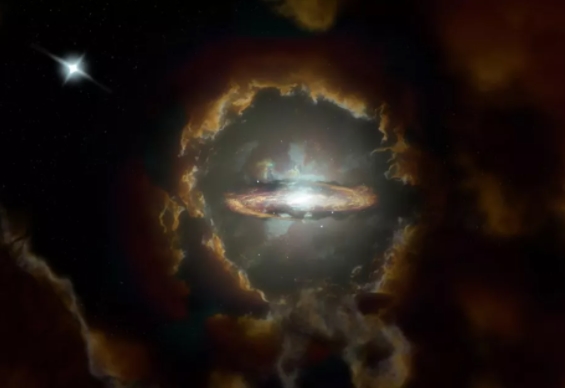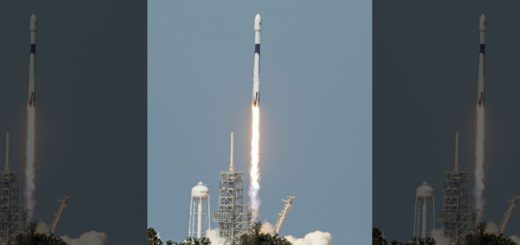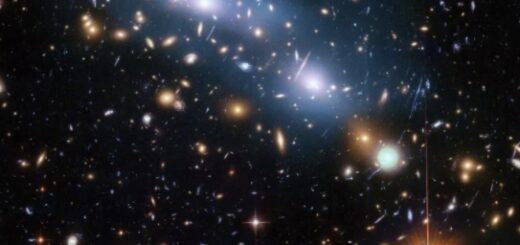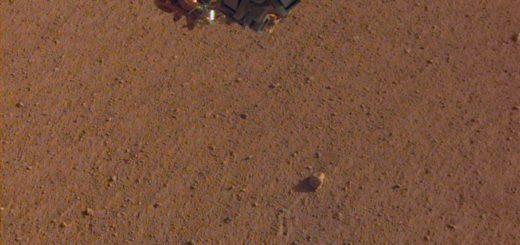Why are galaxies different shapes?

Look into the night sky and you’ll glimpse the stars from hundreds of billions of galaxies. Some galaxies are swirling blue disks like our own Milky Way, others are red spheres or misshapen, clumpy messes or something in between. Why the different configurations? It turns out that a galaxy’s shape tells us something about the events in that galaxy’s ultra-long life.
At the very basic level there are two classifications for galaxy shapes: disk and elliptical. A disk galaxy, also called a spiral galaxy, is shaped like a fried egg, said Cameron Hummels, theoretical astrophysicist at Caltech. These galaxies have a more spherical center, like the yolk, surrounded by a disk of gas and stars — the egg white. The Milky Way and our nearest galaxy neighbor Andromeda fall into this category.
In theory, disk galaxies initially form from clouds of hydrogen. Gravity draws the gas particles together. As the hydrogen atoms draw closer, the cloud begins to rotate and their collective mass increases, which causes their gravitational force to also go up. Eventually, the gravity causes the gas to collapse into a swirling disk. Most of the gas is in the rim, where it feeds star formation. Edwin Hubble, who confirmed the existence of galaxies beyond our own only a century ago, called disk galaxies late-type galaxies because he suspected their shape meant they formed later in the history of the universe, according to NASA.
Alternatively, elliptical galaxies — what Hubble called early-type galaxies — appear to be older. Instead of rotating, like disk galaxies, stars in elliptical galaxies have more random movement, according to Robert Bassett, an observational astrophysicist who studies galaxy evolution at Swinburne University in Melbourne, Australia. Elliptical galaxies are thought to be a product of a galaxy merger. When two galaxies of equal mass merge, their stars start to tug on one another with gravity, disrupting the stars’ rotation and creating a more random orbit, Bassett said.
Not every merger results in an elliptical galaxy. The Milky Way is actually quite old and large, but maintains its disk shape. It’s been adding to its mass by simply drawing in dwarf galaxies, which are much smaller than our home galaxy, and collecting free gas from the universe. However, Andromeda, our disk-shaped sister galaxy, is actually headed straight for the Milky Way, Bassett told Live Science. So billions of years from now, the two spiraling galaxies could merge and each of the duo’s starry disks will offset the other’s rotation, creating a more random elliptical galaxy.
These mergers are far from instantaneous. They take hundreds of millions, even billions of years. In fact, there are ongoing mergers that are moving so slowly — from our perspective — that they appear static. “They’ve basically been in the exact same state, unchanged for all of human civilization,” Bassett said. Hubble gave these galaxies their own classification — irregular galaxies. To look at them, “they are usually a mess with multiple components,” Hummels said. “Irregular galaxies just look like a big train wreck,” Bassett added.
This galaxy is known as Mrk 820 and is classified as a lenticular galaxy. Surrounding Mrk 820 is a slew of other galaxy types from elliptical to spiral.
This galaxy, known as Mrk 820, is classified as a lenticular galaxy. Surrounding Mrk 820 is a slew of other galaxy types from elliptical to spiral. (Image credit: ESA/Hubble & NASA and N. Grogin (STScI), Acknowledgement: Judy Schmidt)
Finally, a less common shape, lenticular galaxies seem to be a mix between an elliptical and a disk galaxy. It may be, Bassett said, that when a disk galaxy uses up all its gas and can’t form any new stars the existing stars begin to interact. Their gravitational tug on one another creates a shape that looks like a lentil — kind of elliptical but still a rotating disk.
What scientists have uncovered so far about galaxies and their 3D shapes has been inferred using thousands of 2D images and by relying on other properties, such as galaxy color and motion, to fill in the blanks, Bassett said.
For example, the younger age of disk galaxies is corroborated by their blue color. Blue stars are generally larger, and they burn faster and hotter (blue light has a higher frequency and is thus more energetic than red light). Meanwhile, elliptical galaxies are filled with older stars — called red dwarfs — that aren’t burning quite as hot or fast.
Still, despite all we have learned about the massive celestial structures around us, there’s still so much we don’t know, Hummels said.
“Galaxy formation and evolution is one of the biggest open questions in the field of astronomy and astrophysics,” Hummels said.
Originally published on Live Science.
Look into the night sky and you’ll glimpse the stars from hundreds of billions of galaxies. Some galaxies are swirling blue disks like our own Milky Way, others are red spheres or misshapen, clumpy messes or something in between. Why the different configurations? It turns out that a galaxy’s shape tells us something about the events in that galaxy’s ultra-long life.
At the very basic level there are two classifications for galaxy shapes: disk and elliptical. A disk galaxy, also called a spiral galaxy, is shaped like a fried egg, said Cameron Hummels, theoretical astrophysicist at Caltech. These galaxies have a more spherical center, like the yolk, surrounded by a disk of gas and stars — the egg white. The Milky Way and our nearest galaxy neighbor Andromeda fall into this category.
In theory, disk galaxies initially form from clouds of hydrogen. Gravity draws the gas particles together. As the hydrogen atoms draw closer, the cloud begins to rotate and their collective mass increases, which causes their gravitational force to also go up. Eventually, the gravity causes the gas to collapse into a swirling disk. Most of the gas is in the rim, where it feeds star formation. Edwin Hubble, who confirmed the existence of galaxies beyond our own only a century ago, called disk galaxies late-type galaxies because he suspected their shape meant they formed later in the history of the universe, according to NASA.
Alternatively, elliptical galaxies — what Hubble called early-type galaxies — appear to be older. Instead of rotating, like disk galaxies, stars in elliptical galaxies have more random movement, according to Robert Bassett, an observational astrophysicist who studies galaxy evolution at Swinburne University in Melbourne, Australia. Elliptical galaxies are thought to be a product of a galaxy merger. When two galaxies of equal mass merge, their stars start to tug on one another with gravity, disrupting the stars’ rotation and creating a more random orbit, Bassett said.
Not every merger results in an elliptical galaxy. The Milky Way is actually quite old and large, but maintains its disk shape. It’s been adding to its mass by simply drawing in dwarf galaxies, which are much smaller than our home galaxy, and collecting free gas from the universe. However, Andromeda, our disk-shaped sister galaxy, is actually headed straight for the Milky Way, Bassett told Live Science. So billions of years from now, the two spiraling galaxies could merge and each of the duo’s starry disks will offset the other’s rotation, creating a more random elliptical galaxy.
These mergers are far from instantaneous. They take hundreds of millions, even billions of years. In fact, there are ongoing mergers that are moving so slowly — from our perspective — that they appear static. “They’ve basically been in the exact same state, unchanged for all of human civilization,” Bassett said. Hubble gave these galaxies their own classification — irregular galaxies. To look at them, “they are usually a mess with multiple components,” Hummels said. “Irregular galaxies just look like a big train wreck,” Bassett added.
This galaxy is known as Mrk 820 and is classified as a lenticular galaxy. Surrounding Mrk 820 is a slew of other galaxy types from elliptical to spiral.
This galaxy, known as Mrk 820, is classified as a lenticular galaxy. Surrounding Mrk 820 is a slew of other galaxy types from elliptical to spiral. (Image credit: ESA/Hubble & NASA and N. Grogin (STScI), Acknowledgement: Judy Schmidt)
Finally, a less common shape, lenticular galaxies seem to be a mix between an elliptical and a disk galaxy. It may be, Bassett said, that when a disk galaxy uses up all its gas and can’t form any new stars the existing stars begin to interact. Their gravitational tug on one another creates a shape that looks like a lentil — kind of elliptical but still a rotating disk.
What scientists have uncovered so far about galaxies and their 3D shapes has been inferred using thousands of 2D images and by relying on other properties, such as galaxy color and motion, to fill in the blanks, Bassett said.
For example, the younger age of disk galaxies is corroborated by their blue color. Blue stars are generally larger, and they burn faster and hotter (blue light has a higher frequency and is thus more energetic than red light). Meanwhile, elliptical galaxies are filled with older stars — called red dwarfs — that aren’t burning quite as hot or fast.



 Creators of mankind
Creators of mankind Description of “Tall white aliens”
Description of “Tall white aliens” Where they came from?
Where they came from? About hostile civilizations
About hostile civilizations The war for the Earth
The war for the Earth “Tall white aliens” about eternal life
“Tall white aliens” about eternal life Video: “Nordic aliens”
Video: “Nordic aliens” Aliens
Aliens Alien encounters
Alien encounters The aliens base
The aliens base UFO
UFO Technology UFO
Technology UFO Underground civilization
Underground civilization Ancient alien artifacts
Ancient alien artifacts Military and UFO
Military and UFO Mysteries and hypotheses
Mysteries and hypotheses Scientific facts
Scientific facts


















